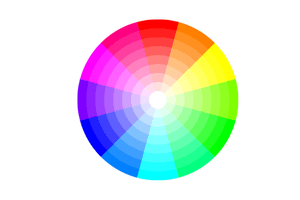So many colours to choose from
Are you thinking of starting your own small business? Or are you about to undergo a rebrand. Both projects will entail decision making around the topic of brand colour.
When I commenced my new small business, I needed to make some big decisions surrounding my branding and what colours I wanted to use. I had studied and worked in marketing, so I knew the significance of colour in a brand. It’s more than just choosing your favourite colour and some thought should go into the decision.

The reasons behind Crystal Lobban Creative’s brand colour and logo design.
- blue for trust, loyalty and positiveness
- orange for warmth, passion and energy
- two high-contrast and high-impact colours
- complementary colours on opposite sides of the colour wheel
- the letter ‘C’ in white for ‘Crystal’
- the tick portraying a ‘yes, can be done’ attitude

Why is colour a significant factor in branding?
The first thing someone often sees when researching your business or seeing it advertised, is your brand colours. Do they stand out? Do the colours have meaning? And most importantly do they blend well together?
I often see branding with colours that don’t appear to have a connection to the business from a colour point of view. The colours chosen may have a special meaning to the owner and that’s part of their personal business story.
Colour is a significant factor when deciding on your business branding. You want your logo to stand out and at the same time build brand identity for your business.
When designing your logo and selecting colours, it’s important to think about how it will look on marketing material. Will it look great on business cards, letterheads and signage? What about on your website – one of your biggest marketing assets? After all you want your logo and colours to grab people’s attention and create a lasting impression.
Colour psychology
Colour psychology is real. How people view your brand can be because of how your branding looks including colour. It’s all about how colour influences human behaviour. It’s natural for a person’s eyes to be driven to the colour within a logo. We associate different emotions and behaviours with certain colours. Some people will see red as a negative (stop, red flag and warning) whilst others may see it as a positive (hot and fast). Colour can signify what industry your business may be in and connect to your target audience.
Starting with the warm colours that get people excited, energetic and joyful, here are some westernised colour psychological observations:
- orange (confidence, warmth, friendly)
- yellow (bright, cheerful, warmth)
- red (excitement, adventurous, powerful)
The cooler tones of the colour wheel can signify a calmer demeanor.
- green (lush, growth, peaceful)
- blue (positiveness, trustworthiness, loyalty, stability)
- purple (creativeness, royalty, luxury)
- pink (feminine, romance, lightheartedness)
Colour wheel and harmonies

Using too many colours in your brand can distract the eye. It’s a good idea to choose 2 or 3 colours that you can use consistently throughout your business brand.
The colour wheel illustrates the primary and secondary colours and their relationship to each other. Some ways you can choose your colours is to use the following colour harmonies from the colour wheel to pick two or three colours.
- Analogous: 3 colours beside each other
- Complementary: 2 colours opposite each other
- Triad: 3 colours opposite each other in a triangle formation
If you have picked one colour based on colour psychology and the industry your business is in, then the above harmonies can help you select the other colours.
Well-known brands and their colours and design
Have a think about some of the brands that you know and see if you can work out the significance of why they may have chosen that colour. I recently saw a draft of two potential logos for a rural hairdresser. The colour of the font was a golden colour – I could tell why they had chosen that colour – it matches not only hair colour but also grain crops. An environmental business could have greens and browns signifying the land.
Woolworths have a green apple connecting fresh produce to their stores. The McDonalds ’big M’ in yellow represents the colour of their famous golden fries. The red signifies fast and hot.
The design also plays a part and can be used to highlight two or three colours. Fedex, the well-known courier company uses purple and orange. Two eye catching and contrasting colours that work well together. Can you spot the hidden forward arrow in the logo? This arrow signifies parcels on the move for delivery. Clever and subtle, with meaning.
The logo for the Murray-Darling Basin Authority includes three colours in the shape of a rain drop. Why a rain drop shape? It signifies its association with water. The main colour is blue representing water, with a splash of green and yellow representing land and the environment. They have integrated the blue and green into the font whereby they have ‘Murray’ in blue and ‘Darling’ in green – the two major rivers in the basin.

Using colour in your branding
Once you have chosen your brand colours, it’s time to apply it to your branding. Consistency, consistency, consistency – one thing that is essential to build brand identity. Make sure you use the same colour scheme throughout your website and marketing material. And remember, only use a few colours – colours that work with each other.
It’s a good idea to use warm colours as one of your secondary colours. Too much use can be over stimulating and distract from the content. Then use your cooler colour as your dominant colour. This applies to backgrounds, images and font colour.
Be consistent with your font style – stick with the one font group. A style guide is an important document for a business to have. It details all your colours including varying shades (HEX, RGB and CMYK codes) and the font style including bold, semi bold, normal and italics versions. Dark font belongs on your light coloured background and light font on a darker background or image. You are not going to win customers and clients by having white font on a light background making it impossible to read.
Think about your design from a reader’s point of view. 1. Does it stand out? And 2. Is it easy to read and digest?
Do you need someone to help you with designing your marketing material including brochures, flyers, pamphlets, posters or PowerPoint presentations?
Your content should be presented in a manner that builds brand identity, looks professional and talks to your target audience.

Over to you
What colours do you have in your brand?
Do you have a story behind your chosen colours? I would love to hear your branding story.
If you would like someone to design your marketing material using your colour palette, please get in touch. Send an email to crystal@crystallobbancreative.com.au and let your marketing material create that lasting colourful impression.
